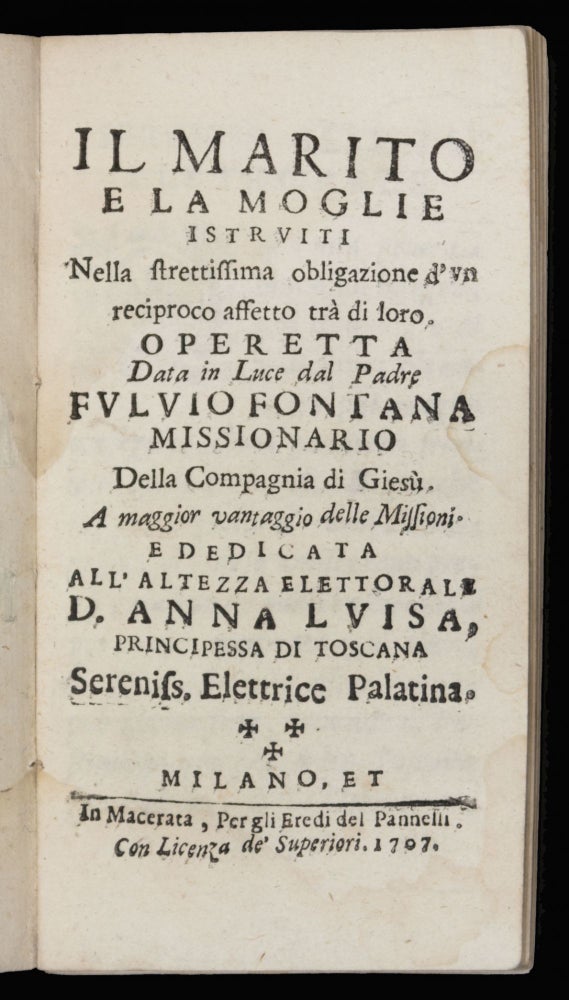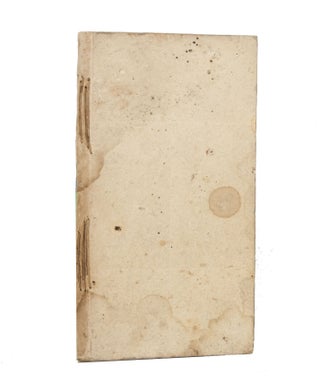Il marito e la moglie istruiti nella stretissima obligazione d’un reciprico affetto trà di loro.
12mo [13.7 x 7.3 cm], (1) f. half title, (1) f. title, (6) ff., 119 pp., (3) pp. Contemporary long-stitch cartone binding, very well preserved apart from some minor staining. Occasional unobtrusive pale dampstaining internally. A genuine copy. Extremely rare early 18th-century Italian handbook offering advice to husbands, wives and their priests about how to maintain a happy marriage (or at least how to keep the peace). Il marito e la moglie is the work of the Jesuit Fulvio Fontana (1649-1723), who shaped the manual for the use of missionaries (“A maggior vantaggio delle Missioni”) tasked more with offering practical advice to congregants than with policing sacramental purity. We have located no copies worldwide of this 1707 edition, and just 4 global copies of other editions (1705, 1706, 1715), none of which today are housed outside of Italy and Switzerland (according to OCLC, KVK & OPAC). That the title was published in multiple editions but now is recorded in just 5 copies suggests that such pastoral care manuals were so popular that they were used to bits. The present example, however, is wonderfully preserved, all but untouched in its contemporary long-stitch cartone binding. Published in Macerata (Le Marche), in a portable 12mo format, Il marito e la moglie discusses the virtues of fidelity, reciprocal spousal support, and mutual respect in marriage, drawing on simple tales from secular and sacred history. Husbands and wives are encouraged to accept each other’s faults and are given advice about potential roadblocks to marital success, e.g., jealously, when in-laws press for more grandchildren, when one is confronted with the untimely death of a child, etc. Special attention is given to the pitfalls of modern life, for example, the temptations faced when one encounters the opposite sex in the streets, at festivals, in church, in carriages, in the game room, and at dances. Fulvio Fontana collaborated with and continued the work of the celebrated Jesuit missionaries Paolo Segneri (1624-94) and Giovanni Pietro Pinamonti (1632-1703), who in the second half of the 17th century preached hundreds of missions in north Italy and the Papal States, traveling from town to town using a highly theatrical method in which they imitated the austere original missions of the Apostles. The Segneri-Pinamonti-Fontana mission typically lasted eight days in each town and was carefully planned with a daily schedule of songs, processions, dialogues, catechism lessons, penitential theatrics, and individual confessions, with topics changing from day to day. Fontana notes that he wrote in wintertime, as a sort of off-season missionary exercise, and it is easy to imagine that the book was called into service when these missionary camps began again in the spring. In his preface to Il marito e la moglie, Fontana signals his desire to develop the concept as a series, and he did publish a sequel of sorts, Il padre e la madre di familia, in 1706 (also very rare). His several other publications treat Jesuit history, provide models for Christian instruction, and record his sermons. That some of these titles appeared in German translation squares with Fontana’s considerable missionary influence in Switzerland and across the Alps. OCLC, KVK, and OPAC locate no examples of the present 1707 Macerata edition. The 1705 first edition (In Milano, per li Fratelli Sirtori stampatori Arcivescovali) is at the Biblioteca comunale Francesco Antolisei (San Severino, Marche) and the Luzern Zentral- und Hochschulbibliothek. The 1706 edition (In Milano & in Bologna, per Ferdinando Pisarri) is at the Biblioteca e Musei Oliveriani (Pesaro). The 1715 edition (In Bologna, per Ferdinando Pisarri, all’insegna di S. Antonio) is at the Biblioteca comunale Manfrediana (Faenza). * De Backer and Sommervogel, vol. 3, cols. 849-51; R. Bireley, The Refashioning of Catholicism, 1450-1700: A Reassessment of the Counter Reformation, pp. 98-100.
Price: $1,500.00


